Listing education on a resume is fairly easy. But you know what else is easy? Messing it up.
If you’re a recent grad, a candidate without experience, or still a student, the education section can be a focal point of your resume and help you land more interviews than you thought possible.
A seasoned pro? The last thing you want is a rookie mistake in the education section that will make you look amateurish.
In this article, we will show you:
- Where to put the education section on your resume
- How to format it
- How to fill it out, no matter your level of education and experience.
Students, recent grads, people without experience, experienced candidates, PhD candidates, people with a high-school degree, people without a high-school degree — we got you all covered.
Let’s begin.
Where to Put the Education Section on a Resume
If you have relevant experience (1+ years), work experience will be the first section on your resume, right below the contact details and resume summary. Your education section, in this case, goes below the work experience section.
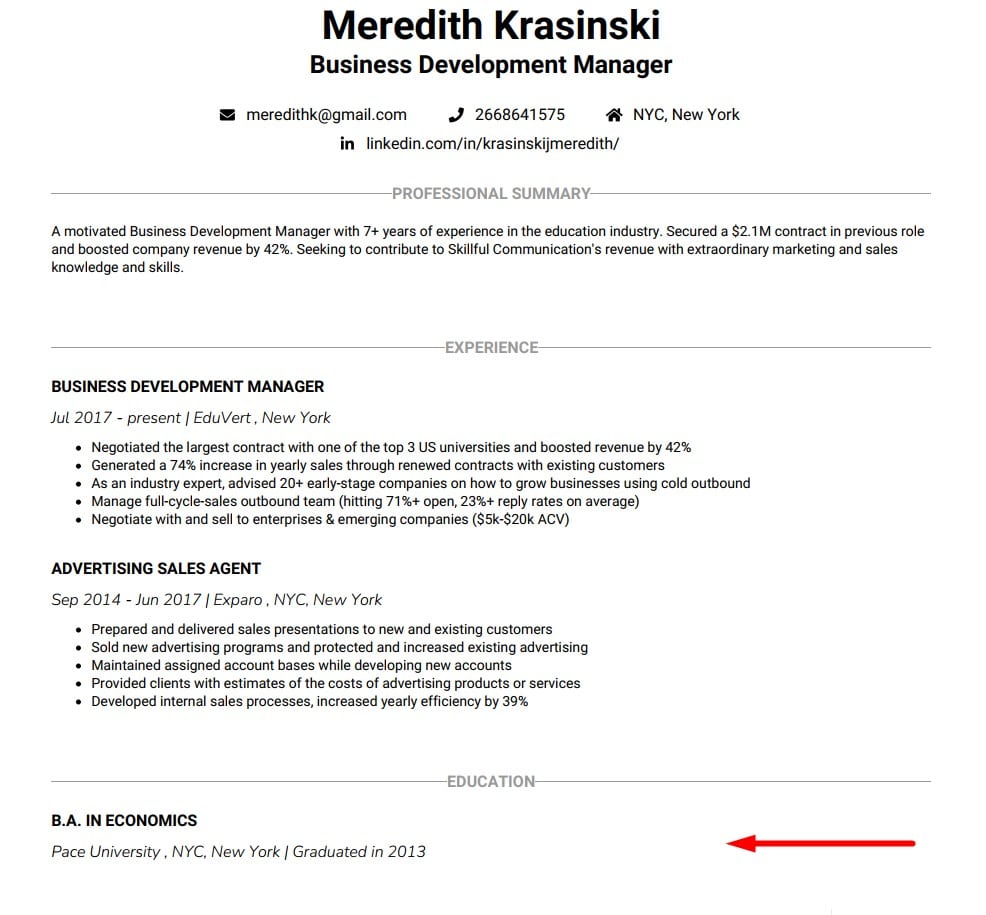
If you don’t have experience, if you’re still a student, or if you’re a recent graduate, then you can rearrange the work history and education sections and place the education section on top.
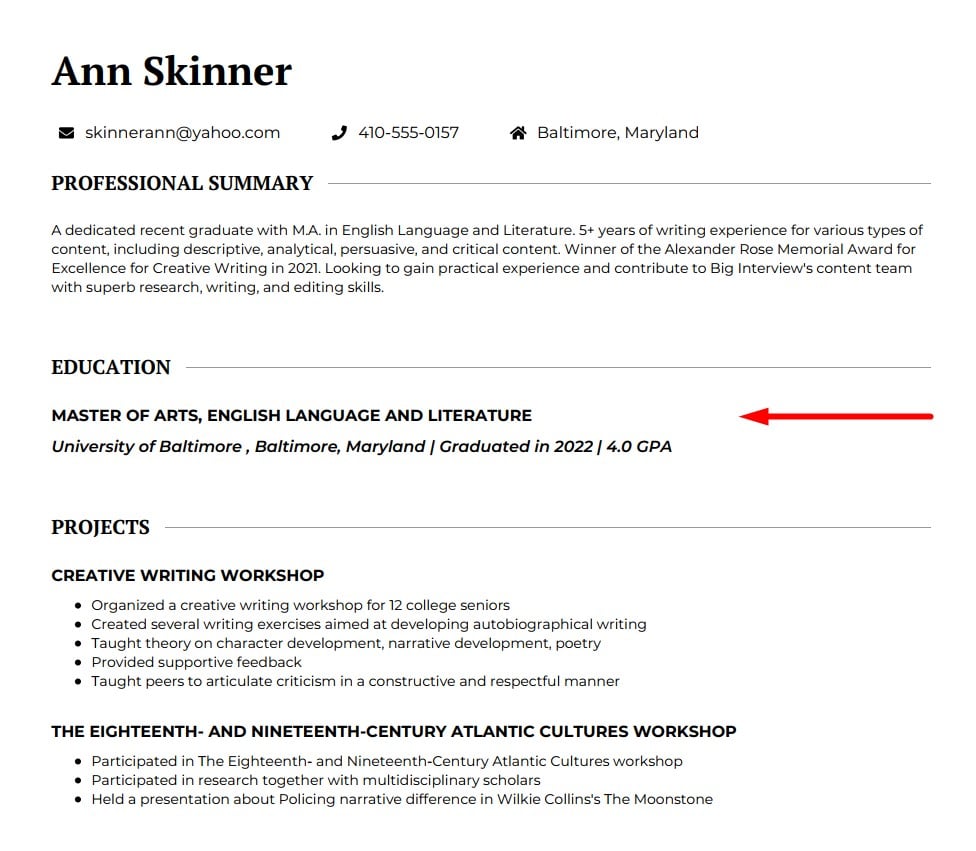
The logic is this: the top third of your resume is the most important, as it’s readily visible as soon as someone opens up the document. This is where the key things that make you a great fit for a position are included.
If that happens to be work experience, great. If it’s education, that’s totally valid too, especially if you’re new to the workforce. In such cases, you can list your education first, at the top of the resume.
If you’re writing an Academic CV and not a resume, placing your education first is a must, as it’s way more relevant than your experience outside of academia.
That said, a CV is an entirely different document — you’ll find tips on how to create an academic CV here.
How to Structure Your Resume’s Education Section
First, create a separate section with an “Education” heading. If you’re using any resume builder, this section will be pre-made and you’ll only need to fill in the details.
From there, you should list your degrees in reverse chronological order, from the most recent, working your way down towards the oldest.
If you’ve finished college, skip the information about high school, as it won’t be relevant.
Listing education for experienced candidates
For experienced candidates, there’s no need to go overboard and include a lot of details. Instead, limit your entries to:
- University name / High school name
- Your degree and major
- Years attended or graduation date
As for the date, you can include the graduation month or limit yourself to the year you graduated If you graduated more than 10 years ago, you don’t have to include the graduation date at all.
What about the order of the items in each entry?
There’s flexibility here. For example, you can choose to start the education section with your degree and list the university after it. Or, if you went to a prestigious university, you can choose to list it first and put emphasis on it.
Here are some examples.

This example was taken from a resume of an experienced candidate. Notice how they chose not to include too many details.

This example was taken from a resume of an experienced candidate with a high school degree but no college education.

This candidate chose to lead with the prestigious university and enter their degree below it. Notice how they omitted the graduation year, as it was a long time ago.
Here are some templates you can use to fill in your education section easily.
Your degree/major
Your university/High School, location, date of graduation
Your university / High school, Location
Your degree, Date of graduation
Your university / High school, Location
Date of graduation
Degree
If you’re an experienced candidate, your skills section will almost certainly matter more than your education. Learn all about creating it from this beast of a guide: How to Put Skills on a Resume
Listing education for candidates without work experience
If you don’t have a lot of work experience or you’re fresh out of college, you need to make the most of what you have. Remember those courses you slaved over in school? Make them work for you now!
Focus on details relevant to the position you’re applying for.
Usually, these are:
- Minors
- Awards and honors
- Relevant coursework
- GPA (only if it’s 3.5 or higher)
- Extracurricular activities, student exchange programs, etc.
- Other academic achievements
Imagine you’ve just finished your English studies and you’re aiming for a Content Writer position. Include any fellowships, awards, internships, or certifications that showcase your skills. Take a look at the example below.

- This candidate included their GPA, details about their creative writing award, and a student exchange program.
- Even though they don’t have a lot of practical experience, this will show recruiters that their writing and creative skills are on-point (the award), that they are intelligent and hard-working (GPA), as well as curious and ambitious (went abroad).
- Such candidates will easily gain an advantage in the hiring process.
If you don’t have a lot of practical experience and you want to show off your academic success, consider using these (or similar) templates:
Your degree
University, Date of graduation, GPA
Additional details: Awards, minors, relevant coursework, study abroad programs, and similar
Your university, Location
Date of graduation
Degree, GPA
Additional details: Awards, minors, relevant coursework, study abroad programs, and similar
Bear in mind that some resume builders (including our Big Interview Resume Builder) will let you have additional sections for details such as awards, study abroad programs, and projects you worked on.
In this case, you can focus only on the education basics (university, degree) and cover the details in additional sections below. It gives you extra room to elaborate on the details of each project, award, or course. Plus, it makes those achievements stand out visually.
Here’s what it might look like:
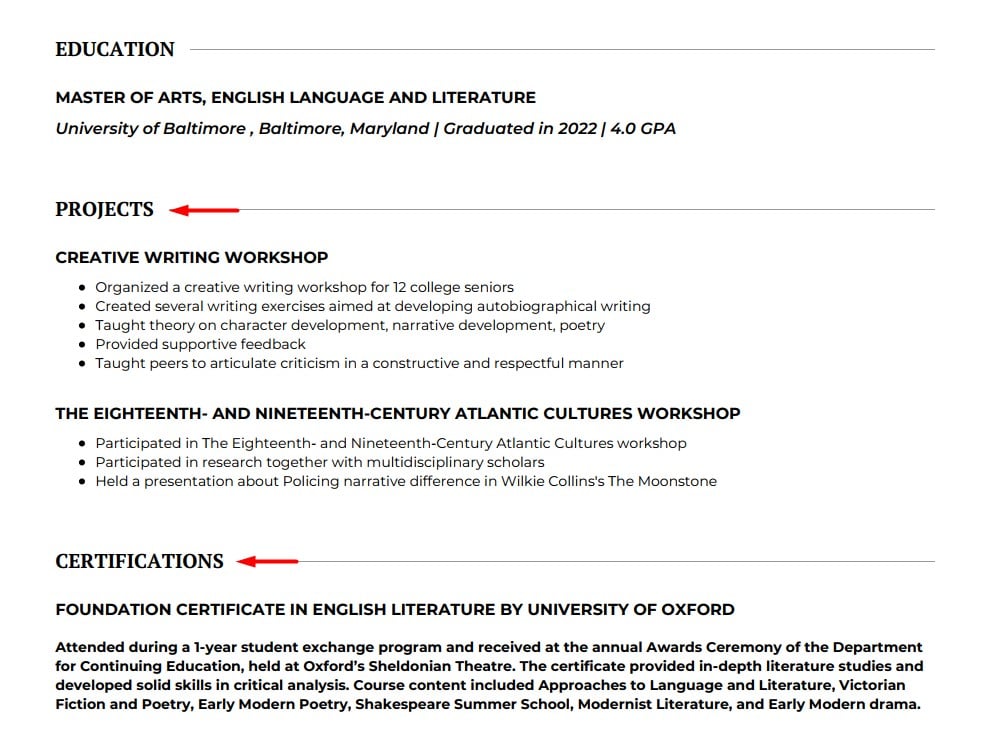
How to List Education on a Resume Depending on Your Education Level
Let’s now go through different ways to list education on a resume depending on your education level.
Some high school, no degree
Still going to high school or never really finished it? Worry not, there are ways to include it in the education section on your resume.
Still in high school
If you’re still in high school, you note the expected year of graduation. For example:
Gateway High School, San Francisco, California
Expected graduation: 2023
You can also list relevant coursework and current GPA if you feel they strengthen your application.

You can use this template:
High school name
Location, Expected graduation date
Relevant coursework, GPA
Did not graduate
If you went to high school for a few years but never graduated, just list the years attended.

Notice how, even though the candidate never graduated, they made sure to include the courses they did cover because those are relevant to the position they’re applying for.
Templates to use:
High school name
Location, Years Attended
Relevant details / coursework
High school name, location
Years attended
Relevant details / coursework
High school or high school equivalent
If you obtained a high school diploma (or its equivalent, GED), things are pretty straightforward.
High school diploma
For a high school diploma, you list the school name, years attended, and, if applicable, GPA and relevant coursework. It’ll look like this:


Templates you can use:
Diploma
High school, location
Year of graduation, GPA
Details: Relevant coursework, awards, honors, projects
High school, location
Year of graduation, GPA
Details: Relevant coursework, awards, honors, projects
High school diploma equivalent
If you haven’t graduated but you do have a high school diploma equivalent (General Education Development certificate), you can refer to it as General Education Development Certificate or GED High School Equivalency.
List it like this:

Templates you can use:
GED High School Equivalency
Issued by
Year of graduation
Details: certificates, awards, etc.
General Education Development Certificate
Issued by
Year of graduation
Details: certificates, awards, etc.
If you have a GED and a professional certificate (or several of them), you can either add them to the education entry under “Relevant details/coursework”.

Or, you can list certificates in a separate section on your resume called Certificates — this allows you to further elaborate on what a certificate or a course entails.
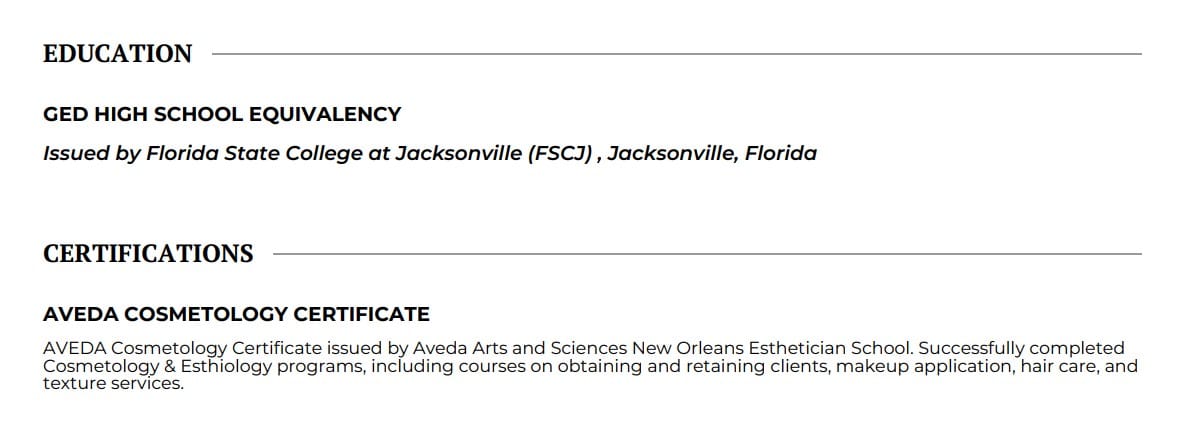
Some college credit, no degree (unfinished/dropped out)
Can you list unfinished education on a resume? Of course!
If you’re still in college or if you dropped out, you can still list that information on your resume. Use what you have!
Still in college
If you’re still in college, list your education like this:

You can also add relevant information regarding coursework, projects, GPA, etc. The main thing here is to include the expected graduation date/year and note that your degree is still in progress.
You can use some of these templates:
Degree (In Progress)
University, Location
Expected graduation:
Details:
In progress: Degree
University, Location
To be completed in:
Details:
Dropped out
If you dropped out, the main thing is to note down your credits. Including relevant courses you went through that can prove useful in the workplace is highly recommended.

Templates to use:
Completed X credits towards Y
University, Location
Relevant coursework (Optional)
University, Location
Completed X credits towards Y
Relevant coursework (Optional)
Bachelor’s degree, single Major
Here’s how to list your education if you have a BA in a single major.

Pretty straightforward, isn’t it? Here’s a template you can use:
Degree/Major
University, Location
Graduation date, GPA
Additional details (honors, awards)
University, Location
Degree/Major
Graduation date, GPA
Additional details (honors, awards)
Bachelor’s degree, double Major
If you have a double major, make sure to list your primary major first, but both primary and secondary major can be listed in a single line.

Templates to steal:
Degree in X and Y
University, Location
Graduation date, GPA
Additional details (honors, awards)
University, Location
Degree in X and Y
Graduation date, GPA
Additional details
If you have a double major but it brought you two different degrees (for example, Bachelor of Arts and Bachelor of Science), you can list the majors in different rows.

Templates to steal:
University, location
Degree 1, graduation date
Degree 2, graduation date
GPA, Additional details (optional)
Degree type 1
Degree type 2
University, Location, Graduation date
GPA, Additional details
University, Location, Graduation date
Degree type 1
Degree type 2
GPA, Additional details
Bachelor’s degree, Master’s in progress
If you have a BA degree and an MA in progress, you should list both on your resume:
- Put your unfinished Master’s on top.
- List key things such as the university, expected graduation date, and relevant coursework.
- Below that entry, list your Bachelor’s the way you usually would.
Here’s an example:

Templates to steal:
Master’s Degree (In progress)
University, location
Expected graduation date
Relevant coursework or other details
Bachelor’s Degree, GPA (if applicable)
University, location
Years attended
Relevant coursework or other details
Master’s Degree (In progress)
University, location
Expected graduation date
Relevant coursework or other details
Bachelor’s Degree
University, location
Years attended, GPA
Relevant coursework or other details
Master’s degree completed
If you have it completed, you should list both your Master’s and Bachelor’s degree. (But if you have a completed BA and you don’t plan on getting an MA — you list only BA, no need to list high school.)
You need to include your degree (obviously), university, location, and graduation date. You can also add details such as GPA, coursework, awards, honors, and similar.
If you’re especially proud about making it to a prestigious university, you can swap the order of university and degree and place university first, above the degree.
Here’s what this entry looks like:


Templates to steal:
Degree
University, Location, Graduation date
GPA, Additional details
University, Location
Degree
Graduation date
GPA, Additional details
MBA
Having an MBA degree is impressive and you should flaunt it on your resume. The principle is the same as listing a Master’s degree and the key info remains the same: degree, university, years attended/graduation year, GPA and honors or awards, if they are impressive.
Here’s an example:

Template:
MBA in X
University, Location, Graduation date
GPA, additional info (awards, honors, projects) (optional)
PhD
If you already have some work experience, listing your PhD on a resume will resemble listing other degrees: degree, university name, location, and graduation year will be enough.
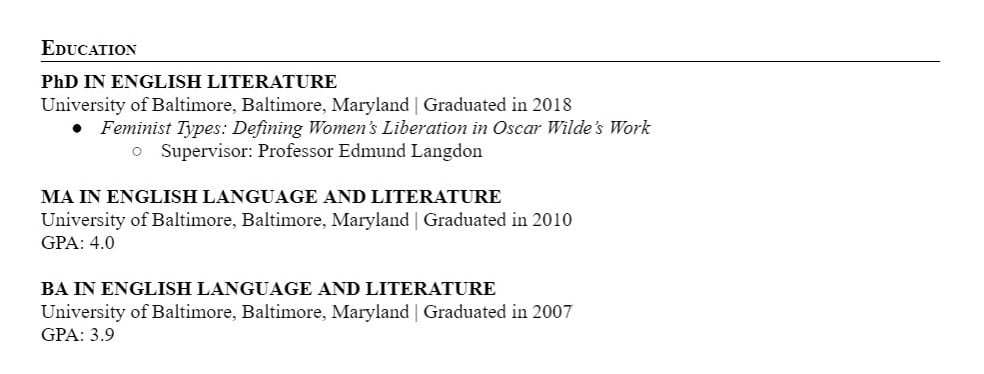
No matter the level of your non-academic work experience, if you have a PhD, you should always list your thesis/disertation title and your supervisor’s name.
In case you need more inspo, here’s what else you can put on a resume.
Key Takeaways
Here are the key things you should remember about how to list education on a resume:
- Recruiters are searching for key information regarding your education that could point them to your skills, work ethic, talents, and interests. Keep it short and relevant!
- If you have relevant experience, place the Work section first and the Education section after it. If you don’t have work experience or are still a student or a recent graduate, place your Education section first and add details (GPA, honors, certificates, papers, projects)
- If you’re still in college, add the expected graduation date
- If you dropped out of college, include completed credits
- If you have completed your Master’s degree, list both MA and BA
- If you have an MBA degree, you list it in the same way as MA or BA degrees
- If you have a PhD and relevant work experience, list only the degree, university, location, graduation date, dissertation, and supervisor. If you don’t have work experience, throw in relevant details such as the coursework, papers and publications, certifications, conferences, etc.
As always, it’s highly recommended that you take a short break after filling out the resume details and come back to it with a fresh pair of eyes. You’ll spot and remove any mistakes and make sure you included all the relevant information.
Looking to find out how to craft every other section of your resume, too? Check out our Resume 101: How to Write a Resume to Land Jobs in 2023
Good luck!
